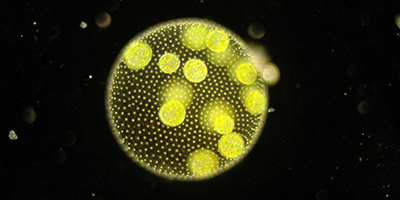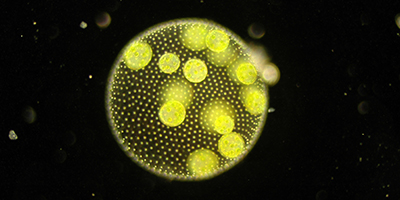Paddling in Sync
The multicellular alga Volvox carteri swims by the concerted beating of hairlike flagella that protrude from each of the thousands of cells on its surface. Neighboring flagella may influence each other’s motion, but it remains unclear whether larger-scale collective synchronization can arise, since this simple organism doesn’t possess a biochemical means of driving its flagella into collective motion. In Physical Review Letters, Douglas Brumley, at the University of Cambridge in the UK, and colleagues show that the flagella can indeed beat in sync, forming collective patterns previously observed only in more tightly packed arrays of cilia, such as those found in the human respiratory system.
Brumley et al. used high-speed imaging techniques to record the flow of liquid around an alga immersed in solution. Their movies show that the flagella beat at the same rate and with a phase pattern that produces so-called metachronal waves, which resemble the “Mexican waves” formed by cheering fans in a stadium. The authors apply a hybrid elastic-hydrodynamic model to explain how two contributions lead to synchronization: The flow of fluid created by a given flagellum nudges its neighbors into synchronized motion, while the surface of the alga further distorts the flow pattern, inducing a phase shift that sets the direction of the wave.
The flagella in Volvox carteri are spaced relatively far apart, and direct mechanical coupling between flagella appears to play only a minor role. The observed hydrodynamic interactions may therefore explain how synchronization emerges in a broad class of biological organisms, similarly characterized by weak mechanical coupling between their motile appendages. – Matteo Rini





